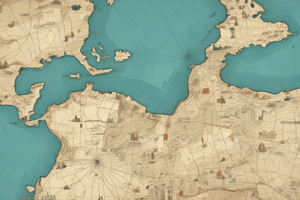Podcast
Questions and Answers
What is the purpose of using scale maps?
What is the purpose of using scale maps?
The purpose of using scale maps is to make ratio information more readable or understandable to an audience and to communicate statistics clearly.
What is the importance of scale maps?
What is the importance of scale maps?
Scale maps are important because they allow us to relate what we see on a map to the real world it is portraying.
What is a scale map?
What is a scale map?
A scale map is a map that includes a scale, which is a ratio of two numbers, and it helps us understand the relationship between the map and the real world.
How did the carpenter's feet affect the size of the bed?
How did the carpenter's feet affect the size of the bed?
What subjects did Elizabeth teach at the college level?
What subjects did Elizabeth teach at the college level?
What degrees does Elizabeth hold?
What degrees does Elizabeth hold?
What is the purpose of a bar scale on a map?
What is the purpose of a bar scale on a map?
What is the difference between a bar scale and a ratio scale?
What is the difference between a bar scale and a ratio scale?
How does a ratio scale on a map work?
How does a ratio scale on a map work?
What is the rule when using a scale map?
What is the rule when using a scale map?
What are the steps involved in creating a scale map?
What are the steps involved in creating a scale map?
Why is it usually easier to use conventional measurements like feet or miles when creating a scale map?
Why is it usually easier to use conventional measurements like feet or miles when creating a scale map?
Explain the concept of scale maps and how they are used.
Explain the concept of scale maps and how they are used.
What does a ratio of 1:87,000 mean in the context of a scale map?
What does a ratio of 1:87,000 mean in the context of a scale map?
What does the term 'unit-less ratio' mean in the context of scale maps?
What does the term 'unit-less ratio' mean in the context of scale maps?
How can scale maps be used to measure distances on the ground?
How can scale maps be used to measure distances on the ground?
What is the process for creating a scale map?
What is the process for creating a scale map?
What are some examples of units of measurement that can be used on scale maps?
What are some examples of units of measurement that can be used on scale maps?
What is the advantage of using a unit-less ratio on a scale map?
What is the advantage of using a unit-less ratio on a scale map?
What is the benefit of using Study.com for learning?
What is the benefit of using Study.com for learning?
Flashcards are hidden until you start studying




